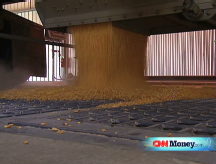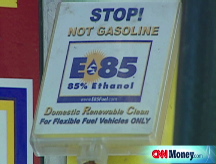Food price spike: Is ethanol to blame?
A devastated corn crop is likely to exacerbate costs at the grocer. Some people are pointing a finger at the ethanol production laws.
NEW YORK (CNNMoney.com) -- It's hard to miss: Americans are paying more at the supermarket checkout these days.
Prices have increased 5% since last year, and it could get worse. The U.S. Department of Agriculture projects that food prices will bump up another 5.5% in 2008.
One of the reasons is that the price of corn - a staple ingredient in a variety of foods from cereals to cola and the main ingredient in animal feed - is selling above $7.50 a bushel, about 119% above the price from a year ago.
The nation's corn crop was hurt by an unusually rainy spring. More recently, the havoc-wreaking floods in the top Midwestern corn-growing states wiped out farms and threaten future harvests.
"It seems pretty clear that we'll have a substantially lower planted acreage than last year, and we'll probably have a lower yield too," said former U.S. Department of Agriculture chief economist Keith Collins, who was commissioned by Kraft Foods to study food prices. "We're looking at a good drop in production, and as a result, corn prices will spike."
Now the rising price of corn is fueling a movement to reduce the amount of corn ethanol that is added to American gasoline.
Ethanol's primary component is corn, so demand for the crop has soared since the ethanol standard was enacted in 2005 and increased with the Energy Independence and Security Act of 2007. The government passed the legislation in an effort to support the U.S. farm and ethanol industry, to promote cleaner-burning fuels and to reduce the nation's dependence on foreign oil.
But in late April, Texas Gov. Rick Perry petitioned the Environmental Protection Agency to grant a 50% waiver on the nation's 9 billion gallon corn-based Renewable Fuel Standard.
"While the RFS was a well intentioned policy, it has had the unintentional consequence of harming segments of our agriculture industry and contributing to higher food prices," Perry wrote in his petition.
The EPA has opened a period of public comment about the standard and will make a decision on the waiver by July 24.
The EPA requires that 7.76% of gasoline products be blended with ethanol in 2008. That amounts to about 9 billion gallons U.S. ethanol producers have to put out this year. Next year, they will have to produce 10.5 billion gallons.
Gov. Perry said the the "artificial pressure" on the corn crop created by the mandate threatens "irreparable damage" to livestock operations across the country.
Ethanol puts pressure on food prices
Critics of the program argue that a corn shortage could be exacerbated by the government's demand for ethanol, thus raising food prices even further for consumers.
"A lot depends on how badly this weather has devastated the corn crop," said Thomas Elam, an agricultural economist at Indiana University who was commissioned by the Balanced Food and Fuel Coalition to release a study on the matter. "A smaller crop will be devastating to meat, dairy, and poultry producers if the Renewable Fuels Standard is maintained, and consumers will suffer as food and fuel costs rise."
About 5% of the world's corn supply goes to producing bio fuels - representing a whopping three years of growth in typical crop production, according to Elam.
"Corn will have to go to at least $8 a bushel to squeeze out enough food use to keep up with corn for ethanol," he said. "Food prices will be significantly impacted by corn if RFS goes to 10.5 billion gallons for 2009."
How significantly? Collins said food costs could rise 23% to 35% above the normal annual inflation rate of 2.5% over the next two to three years if the RFS mandates are not reduced. Elam said food price inflation rate could go as high as 7% without a mandate reduction.
The USDA also maintains ethanol has an impact on food prices, even if it is an indirect link.
"Higher ethanol production definitely and directly raises the price of corn," said USDA economist Ephraim Leibtag. "Higher corn prices have an impact on food prices on the retail level."
By contrast, if the government were to reduce the RFS by just half, both Elam and Collins agree that corn prices would fall $2 a bushel, which could save more than $9 billion in feed and food costs.
The case for the ethanol standard
Not everyone is convinced that ethanol poses such a definite threat to food prices.
"Collins' conclusions are at odds with the conclusions of a number of other ethanol studies," said Geoff Cooper, director of research at the Renewable Fuels Agency. "The global food index has increased 40% and ethanol is only responsible for 2% to 3% of that," he said, referring a study conducted by Bush administration economists.
It's also possible that the corn crop will rebound before the growing season ends in the fall. As a result, Cooper noted the impact that ethanol will take on food prices this year is still up in the air.
Another RFA spokesman suggested that Collins' study was biased, since it was sponsored by Kraft Foods, which would benefit by a reduction in the RFS.
Kraft said that it expects the company's commodity costs to increase 12% or $1.7 billion in 2008, but dismissed the RFA's claim.
"Dr. Collins is a widely-respected, credible and award-winning researcher and former chief economist of the U.S. Department of Agriculture," said Michael Mitchell, a spokesman for Kraft. "His credentials speak for themselves."
Ultimately, Cooper said he doubts that Gov. Perry's waiver request will succeed, because the EPA can only accept a waiver if the law creates significant economic hardship on a state.
"He did not come close to demonstrating criteria of significant economic harm," said Cooper. "The waiver request does not meet the EPA's criteria, because it affects only a fraction of his state's GDP." ![]()





